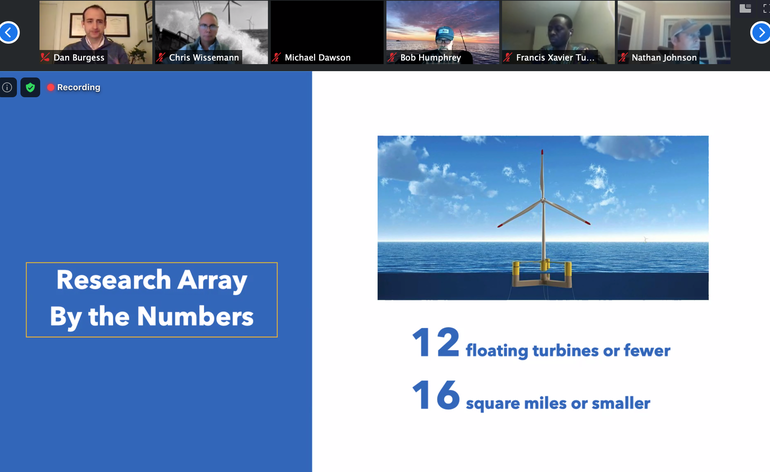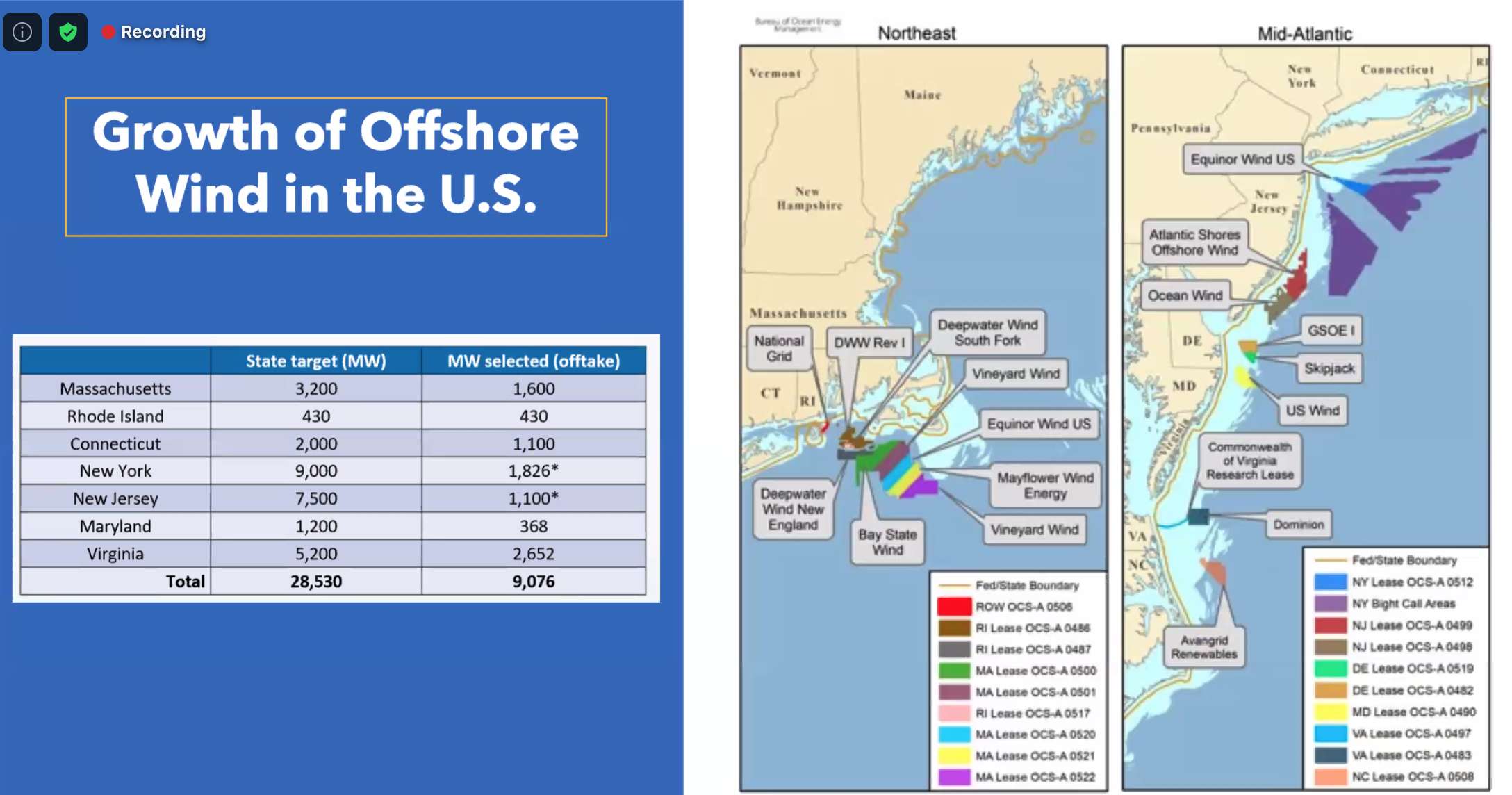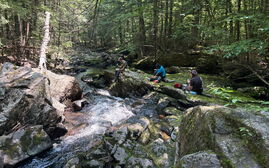
Fishing industry grapples with state’s offshore wind array plan
 Screenshot / Governor’s Energy Office
The state plans to apply for a federal lease to install an offshore wind array for research purposes.
Screenshot / Governor’s Energy Office
The state plans to apply for a federal lease to install an offshore wind array for research purposes.
The state’s plan to install an array of wind-energy turbines off Maine’s southern coast for research purposes has prompted concerns among fishermen.
“You’re shutting down habitat that we fish now so you’ll be displacing a lot of guys who are fishing out there,” said Portland lobster fisherman John Bisnette.
His observations came during an informational webinar hosted Tuesday by the Governor’s Energy Office and the Maine Department of Marine Resources. The Governor’s Energy Office is the lead agency in the array’s development. The webinar was one of three the agency was holding this week and next to get input from the fishing industry about potential siting and impacts of the array.
“The state has initiated a collaborative process that gives fishermen and other stakeholders direct influence in the development of the proposed project,” according to the meeting announcement.
“We want to understand fishing operations in the area,” GEO Deputy Director Celina Cunningham said during the webinar.
The state plans to apply for a lease in federal waters somewhere in a 20- to 40- mile band off the southern half of Maine’s coast, she explained.
“We realize there are concerns about how this new industry will impact people’s livelihoods in the fishing industry,” she said.
The project will consist of up to 12 turbines, whose size has not been determined. The project will cover 16 square miles or less, in 150 feet of water or deeper, somewhere along the southern half of Maine’s coast, on bottom consisting of gravel or mud. The turbines will be in place for 20 years or more, Cunningham said
The state is looking for places where the array would have minimal conflict with known fishing grounds. It hopes to avoid highly trafficked areas, limit visibility from shore and balance of economic and technical considerations, she said.
Bob Humphrey, who runs a Pownal-based sport fishing operation, said he spends May to September in the 20- to 40-mile offshore range
“I think you’d be hard-pressed to find anything here that won’t have significant conflict with fishing, commercial fishing in particular,” said Humphrey. “Any structure out there will be covered in lobster traps.”

The band under consideration is also used by tuna fishermen, groundfishermen and charter fishing operations, he said.
The state aims to find a place that has the least impact and to work with stakeholders to figure out where that place is, Cunningham said.
Advance commercial wind
The goal of the array is to advance commercial offshore wind development in order to mitigate climate change with renewable energy, but to do so in sync with other marine users in order to minimize impacts when siting the project, said Cunningham.
“In the long term, we hope to improve understanding for how commercial development and siting should happen,” she said.
While offshore wind is part of Maine’s renewable energy strategy, the state realizes the technology raises concerns about wildlife, ecosystems, habitat and existing uses, she said.
“We need to pursue this growing industry prudently and cautiously,” she said.
The U.S. Department of the Interior’s Bureau of Ocean Energy Management is responsible for leasing sites in federal waters, which begin 3 miles from the coast.
The state plans to deploy a floating turbine platform developed by the University of Maine. The technology is different from fixed bottom platforms used elsewhere, she said.
The state partnered with New England Aqua Ventus to develop the project. New England Aqua Ventus is a joint venture between Diamond Offshore Wind and RWE Renewables.
In August, Diamond Offshore Wind and RWE Renewables announced they would invest $100 million to build the project and help demonstrate the technology at full scale The firms has global expertise in offshore wind energy.
But siting is the state’s decision, Cunningham added.
The research array is expected to set Maine on a path to build out a commercial sector, she said.

But key to the process, she said, is for other marine stakeholders to be part of the conversation early on.
“It’s our intent to have public input throughout the planning and permitting process,” Cunningham said.
The goal is to submit the lease application to BOEM this winter or early spring, with a specific site for the project.
After submission, the application goes through a federal review process. If a lease is issued, detailed site assessment will take place, followed by further planning with stakeholders over a multiyear timeframe through federal and state permitting processes. It could take about five years to get to construction and installation, with the research project underway in 2025 or later.
As a research project, the goal is to gather information regarding wind operations in the Gulf of Maine, including interactions with the environment and ecology, fishing activity and navigation.
Interactive mapping tools
Meredith Mendelson, deputy commissioner of the Department of Marine Resources, said that agency would post resources online that would assist fishermen in participating in site selection process. That will include documents on the siting process and interactive mapping tools.
The DMR anticipates holding a scoping forum in early January, to review siting criteria, evaluate feasibility of the project in various locations, and review data and areas of fishing industry operations, she added.
Chris Wisseman, CEO of Diamond Offshore Wind, said the goal is to use entirely Maine contractors on the project, and have all the construction done in Maine. The core of the proposal is to utilize what the University of Maine technology and make offshore wind a Maine-based industry.
Underwater transmission routes, from the array to shore, will be a big part of the study, added Wisseman. Thoughts include having the underwater cable follow existing shipping lanes, and also to bury the cable, he said.
Cables from the multiple turbines will be ganged together, from one turbine to the next and, at the last turbine, one big cable will run to shore, he explained.
In October, the U.S. Economic Development Administration awarded $2.166 million grant to the Governor’s Energy Office to develop a roadmap for establishing an offshore wind power industry. The EDA grant will be matched with $267,624 in state funds and $112,457 in local funds.
Offshore wind energy may represent a big opportunity for Maine’s energy and economic future. There is significant interest in commercial development of offshore renewable energy in the Gulf of Maine. The proposed research array is considered a prudent step to take before commercial scale floating offshore wind development occurs in the gulf.
Research is expected to allow the state, the fishing industry and others to learn about potential impacts of floating offshore wind in order to ensure Maine develops the industry in a manner that capitalizes on innovative technology and abundant resources, while protecting the interests, industries, environment and values, according to a news release.
The project could produce more than $125 million in total economic activity and create hundreds of Maine-based jobs during the construction period, according to a news release
Last week, Gov. Janet Mills and Kwasi Kwarteng, a member of the United Kingdom’s Parliament and the U.K.'s minister of state at the Department of Business, Energy and Industrial Strategy, signed a five-year memorandum of understanding to enhance cooperation between Maine and the U.K. on research and development of clean energy technologies aimed at supporting carbon-neutrality efforts.
Click here for more information on the NEAV project.













0 Comments